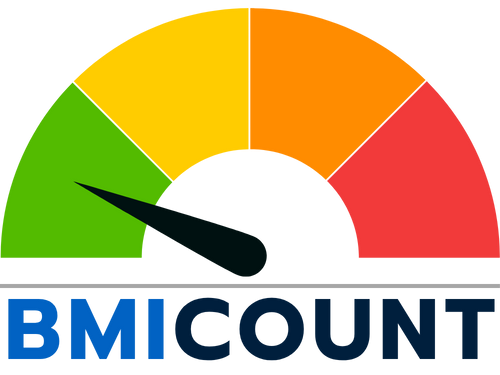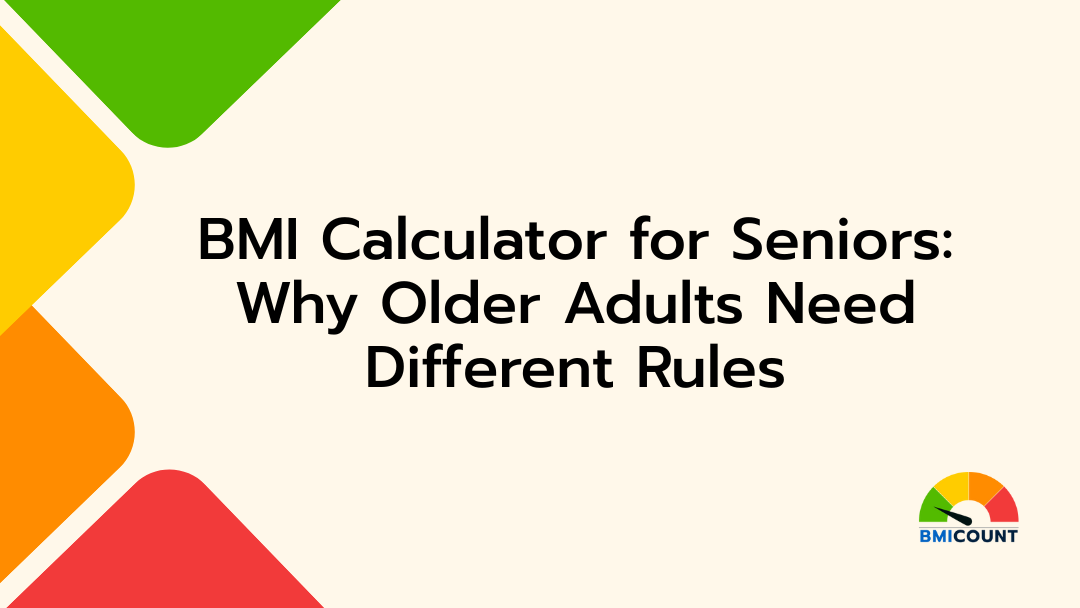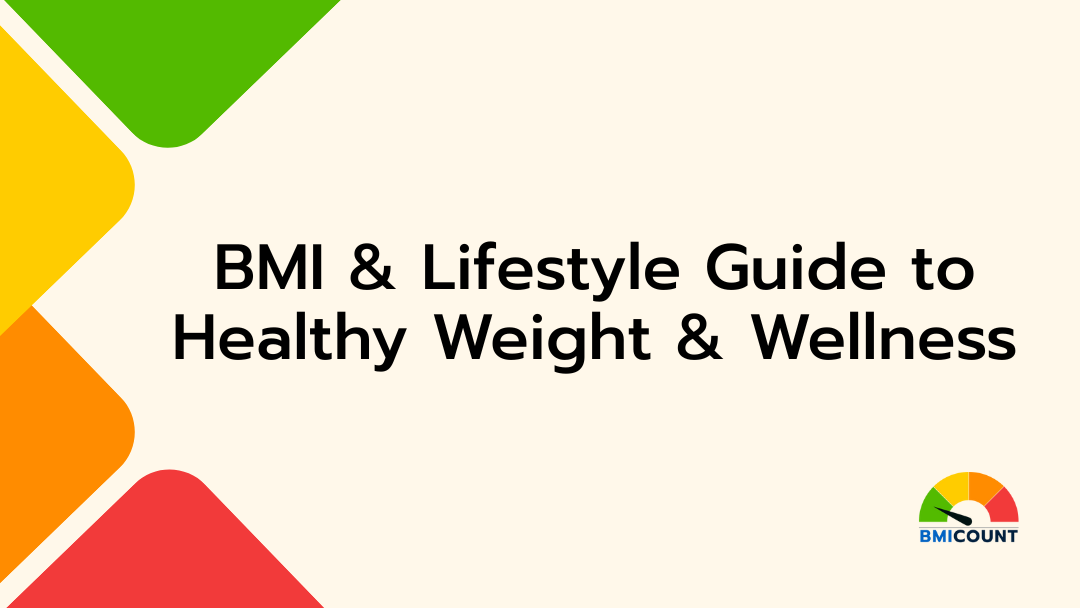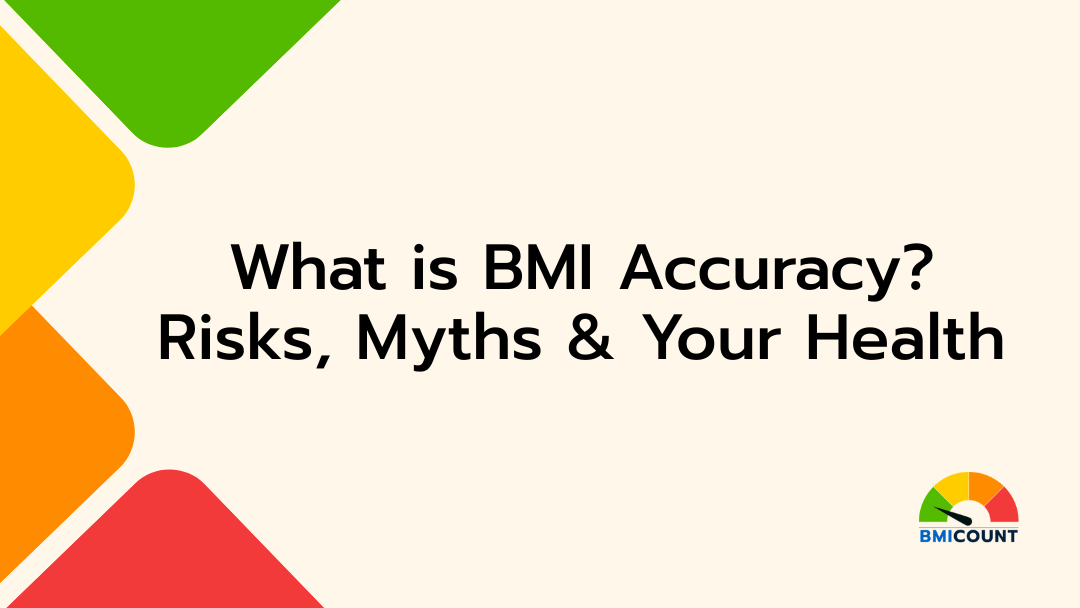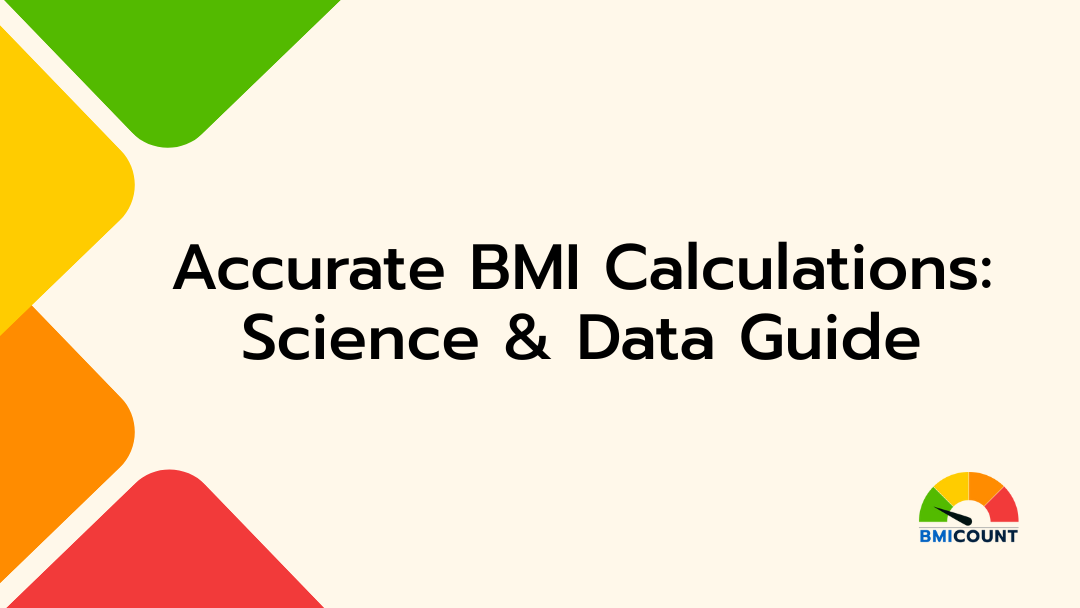BMI in Older Adults Isn’t One-Size-Fits-All
For most adults, Body Mass Index (BMI) has long been used as a quick health indicator a simple ratio of weight to height. But when it comes to older adults, BMI becomes much more nuanced. As we age, changes in muscle mass, bone density, and fat distribution mean the same number may no longer tell the full story.
This is where tools like a BMI calculator for adults come in but with a caveat. For those aged 65 and older, the traditional BMI “healthy range” might not apply in the same way. In fact, research suggests that a slightly higher BMI could actually be protective, especially as age-related muscle loss also known as sarcopenia becomes a concern.
Understanding this shift is key for both seniors and caregivers. A BMI of 25 might raise a red flag for a 30-year-old, but for a 70-year-old, it could indicate stability and resilience. That’s why knowing the ideal BMI for older adults isn’t about chasing “thinness” it’s about promoting strength, nutrition, and overall well-being.
To explore the science and limits behind BMI more deeply, check out our Complete Guide to BMI Calculations and the BMI Accuracy & Risks post.
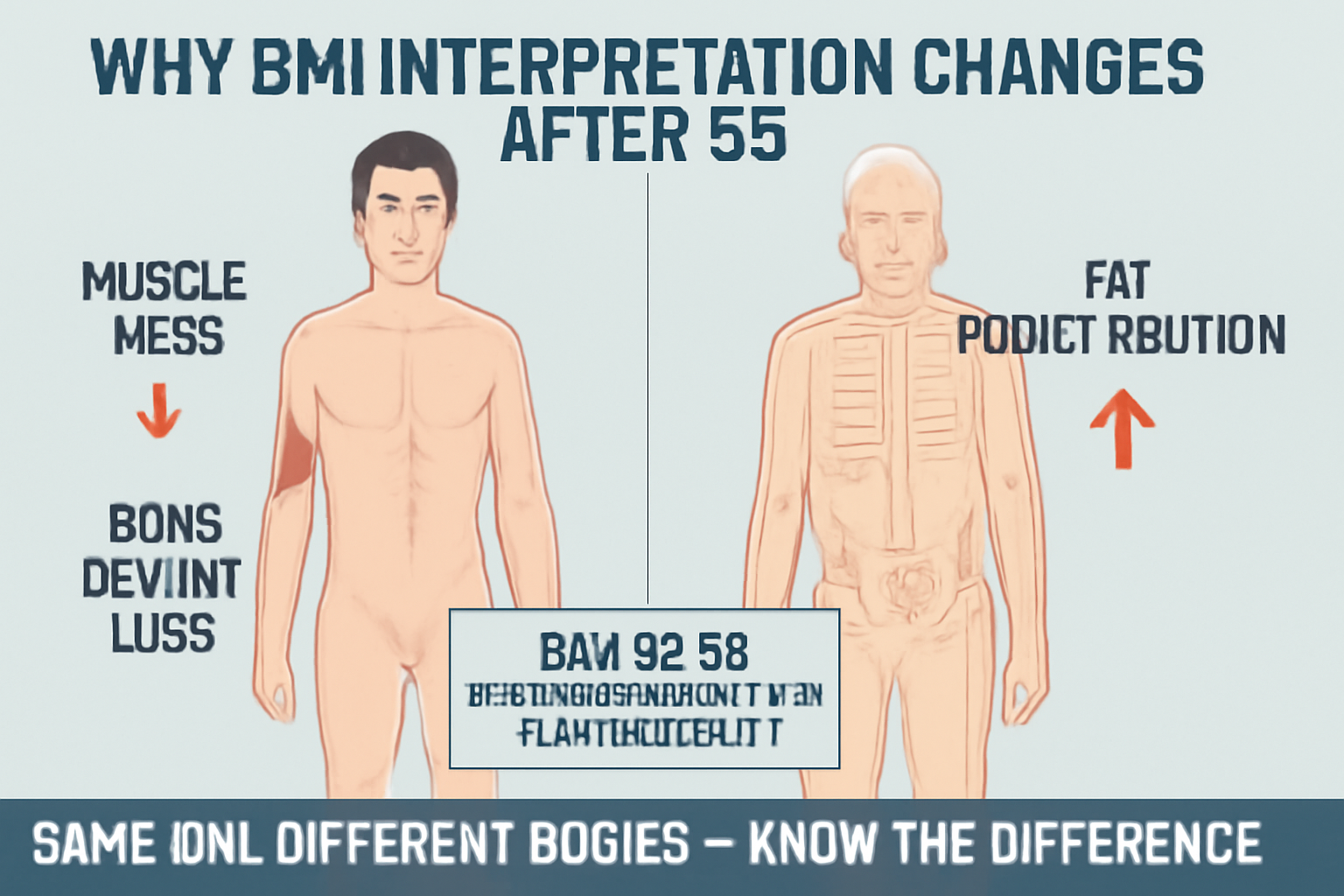
“Using a BMI calculator for adults over 65 requires a different lens where maintaining strength and preventing sarcopenia matter more than fitting into younger BMI ranges.”
What Is Considered a Healthy BMI for Elderly People?
A BMI between 18.5 and 24.9 is considered “normal” for most adults. But for seniors, that range may not always represent the healthiest option. In fact, studies suggest that the ideal BMI for older adults may be slightly higher somewhere in the 24 to 29 range depending on their overall health, mobility, and muscle retention.
Why the difference? As people age, they naturally lose lean body mass, especially muscle, a process called sarcopenia. Muscle weighs more than fat, so even a small drop in muscle can shift BMI lower without indicating better health. In fact, a BMI that’s too low in seniors has been linked to a higher risk of falls, fractures, and even mortality.
Instead of using the same targets as a 25-year-old, we need to view BMI 65+ through the lens of functionality, not appearance.
BMI Ranges: Adults vs. Seniors (Side-by-Side Table)
| Category | Standard Adults (18–64) | Older Adults (65+) |
|---|---|---|
| Underweight | < 18.5 | < 23 (may signal malnutrition) |
| Healthy Weight | 18.5 – 24.9 | 24 – 29 (functionally healthy) |
| Overweight | 25 – 29.9 | 30+ (assess function & comorbidity) |
| Obese | ≥ 30 | ≥ 30 (not always a risk factor) |
📌 Source: WHO, NIH, and geriatric care studies
As the table shows, a healthy BMI for elderly individuals must be interpreted more generously and more holistically. A BMI of 27 might be flagged as “overweight” for a younger adult, but in seniors, it could reflect stability, adequate fat reserves, and reduced frailty.
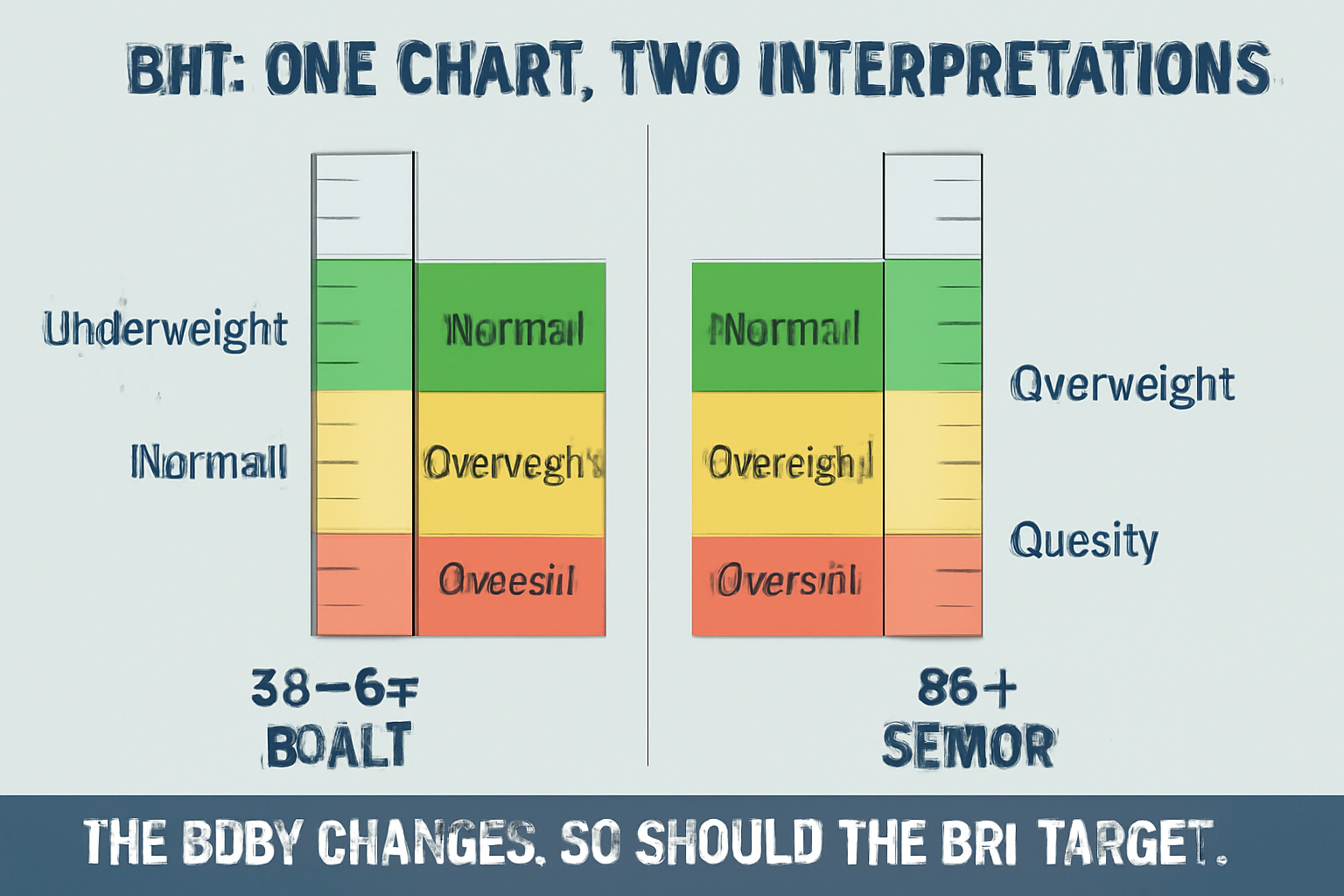
“A healthy BMI for elderly adults may fall outside traditional ranges and that’s not just okay, it may actually be protective.”
Sarcopenia and BMI Why Lower Isn’t Always Better
Most people think of a lower BMI as healthier but for older adults, this belief can be misleading, or even harmful. As we age, we begin to lose muscle mass and strength, a condition known as sarcopenia. This muscle loss often starts around age 50 and accelerates past 65.
Why does this matter? Because muscle weighs more than fat. So when muscle is lost, the body becomes lighter but not necessarily healthier. Seniors with a “normal” BMI may actually be under-muscled and at greater risk for falls, weakness, or injury. This is where understanding the connection between sarcopenia and BMI becomes critical.
Signs That Sarcopenia May Be Affecting Your BMI:
- You’ve lost weight unintentionally
- Daily tasks (e.g., climbing stairs, carrying groceries) feel harder
- Your appetite has decreased
- You feel weaker or more fatigued than usual
- BMI is within “normal,” but strength is declining
Rather than aiming for a “perfect” number, geriatric BMI considerations prioritize function over form. That means watching out for muscle loss, even if the scale or calculator shows a healthy number.
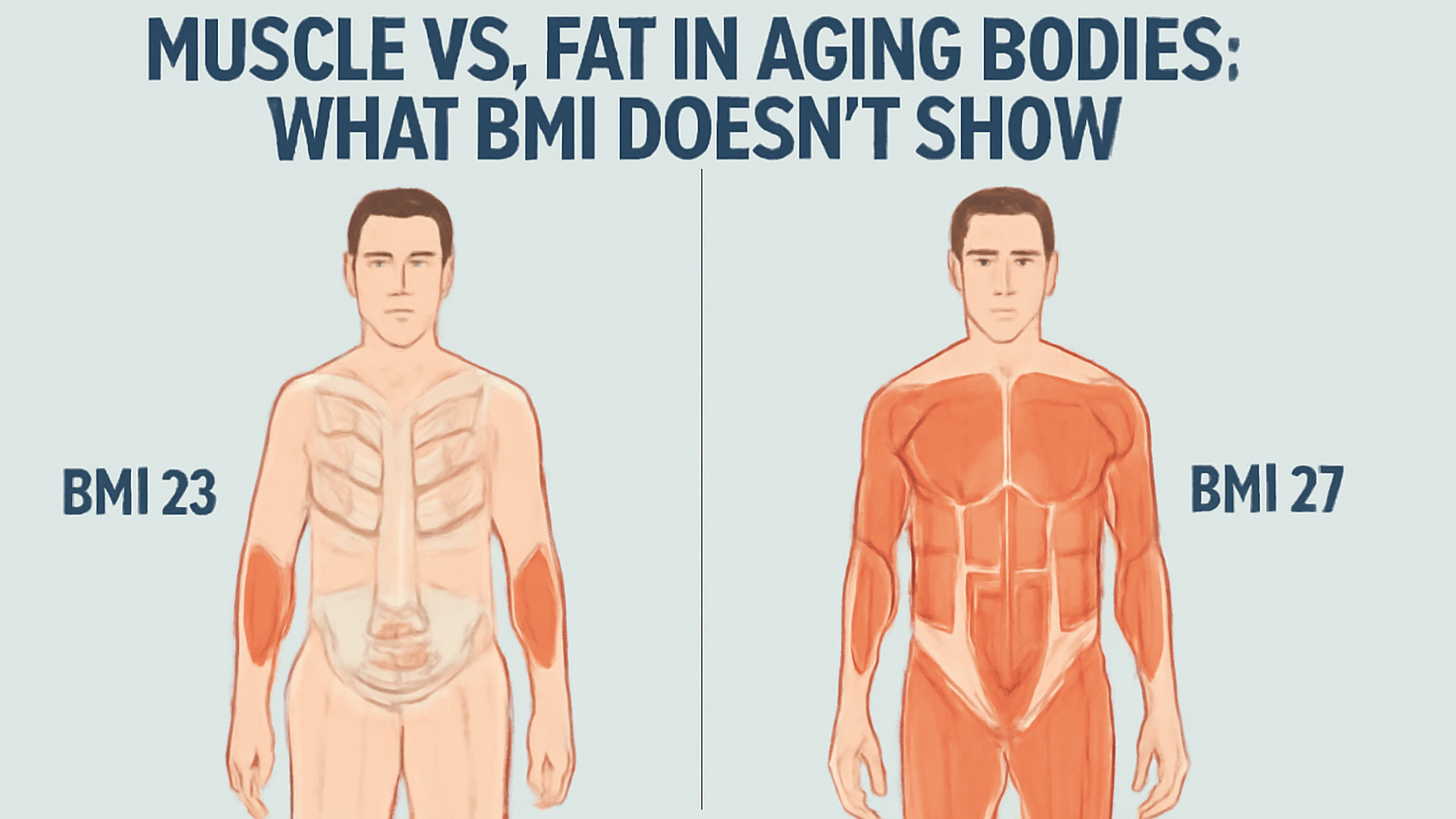
“When sarcopenia reduces muscle mass, BMI alone can’t reflect health that’s why geriatric BMI considerations focus on strength and function, not just numbers.”
Ideal BMI for Older Adults & Interpreting Calculator Results
So what should older adults make of their BMI score? The answer depends on how the result is interpreted. A number alone isn’t enough context is everything.
Using a BMI calculator for adults is a helpful starting point, but for seniors, it’s important to consider how age and muscle mass affect the outcome. At BMIcount.com, when a 70-year-old inputs their details and receives a BMI of 25.0, the calculator doesn’t just label it “overweight.” Instead, it factors in age-specific recommendations and flags it as a healthy weight for seniors which is more medically accurate.
This tailored interpretation aligns with current research: a BMI 65+ between 24 and 29 is often considered optimal for functional aging, stability, and muscle preservation.
What Our BMI Calculator for Adults (65+) Shows
| User Input | Example Output |
|---|---|
| Age | 70 years old |
| Height | 5’6″ |
| Weight | 155 lbs |
| BMI Result | 25.0 |
| Interpretation | ✅ Healthy Weight for Older Adults |
| Wellness Tip | “Focus on nutrient-rich meals to maintain strength.” |
📌 Our tool goes beyond BMI and adds age-appropriate health advice, including sarcopenia considerations.
If your result feels a bit “high” based on traditional BMI charts don’t panic. In older adults, ideal BMI for older adults may reflect protection against frailty, falls, and hospitalization. The calculator result is just one piece of the puzzle.
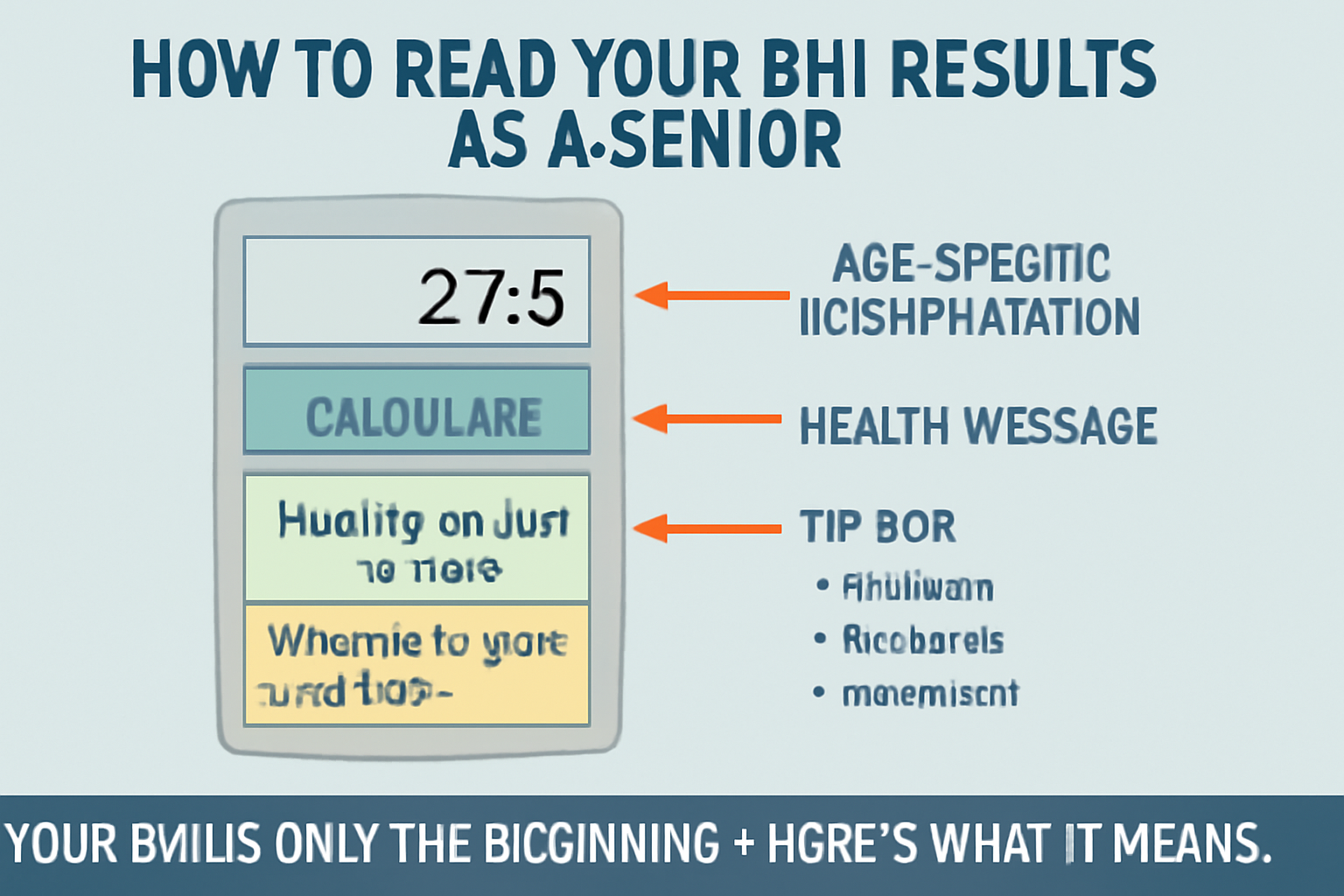
“An ideal BMI for older adults isn’t about being thin it’s about being strong, stable, and well-nourished. Let the calculator guide, but not define you.”
Geriatric BMI Considerations are More Than Just Numbers
For older adults, health isn’t defined by a number on a scale and certainly not by BMI alone. While a BMI calculator for adults gives a helpful snapshot, it doesn’t capture many critical factors affecting senior health. That’s why geriatric BMI considerations are essential to proper interpretation.
In later life, shifts in hydration, fat distribution, bone density, and chronic conditions can all skew what your BMI seems to say. That’s why two people with the same BMI may have very different health profiles, depending on these hidden variables.
Key Geriatric BMI Considerations You Should Know
✔️ Hydration status: Seniors often experience mild dehydration, affecting weight and metabolism
✔️ Bone density loss: Thinner bones = lower weight, which may falsely lower BMI
✔️ Fat redistribution: More fat is stored around the abdomen, even with normal BMI
✔️ Mobility limitations: Affect physical activity, leading to muscle loss
✔️ Medications: Some prescriptions can cause weight gain or loss unpredictably
✔️ Chronic conditions: Conditions like arthritis, diabetes, or heart disease require individualized BMI evaluation
BMI is just one tool not a diagnosis. And for aging bodies, sarcopenia and BMI must be viewed together. If you’re unsure what your number means, speak with a doctor, nutritionist, or physical therapist to assess real-world health.
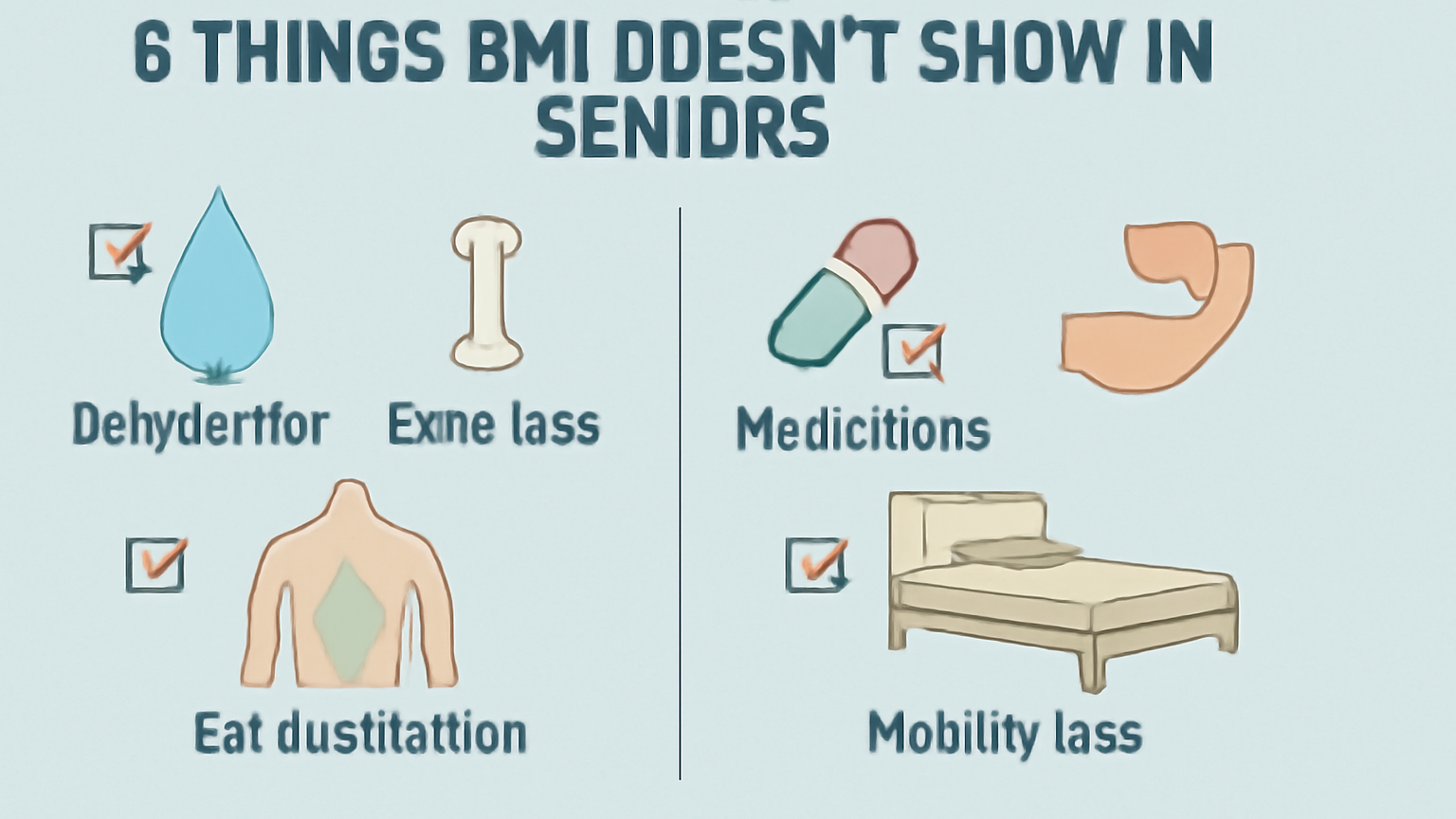
“Geriatric BMI considerations remind us that weight alone doesn’t define senior health hydration, strength, and muscle loss matter just as much, if not more.”
Healthy Habits for Seniors Beyond the BMI
While BMI can offer a general guideline, long-term well-being depends on daily choices especially in older adulthood. Whether your BMI is inside or outside the “ideal” range, what matters most is how you feel, function, and fuel your body. That’s why a healthy lifestyle built around simple, sustainable habits is far more valuable than any number.
If your BMI calculator for adults result is slightly above average, don’t rush to “diet.” Instead, focus on strength-preserving, nutrient-dense, and movement-rich strategies to support graceful aging.
Foundational Healthy Habits for Older Adults
1. Prioritize Protein
- Supports muscle maintenance and reduces the impact of sarcopenia
- Examples: eggs, lean poultry, legumes, Greek yogurt
2. Eat for Energy, Not Just Calories
- Whole foods, healthy fats, and fiber-rich meals keep you energized and nourished
- Focus on nutrient density, especially if appetite is lower
3. Move Your Body Gently and Consistently
- Try walking, water aerobics, light strength training, or stretching
- Regular activity supports balance, mobility, and BMI stability
4. Stay Hydrated
- Dehydration affects metabolism and weight regulation
- Aim for at least 6–8 glasses of water daily
5. Sleep & Stress Management
- Chronic stress and poor sleep can cause weight fluctuation or muscle loss
- Prioritize routine, gentle mindfulness, or rest
This approach doesn’t just support a healthy BMI for elderly individuals it protects dignity, function, and independence. For more structured ideas, explore our BMI and Lifestyle Guide, built for all ages.
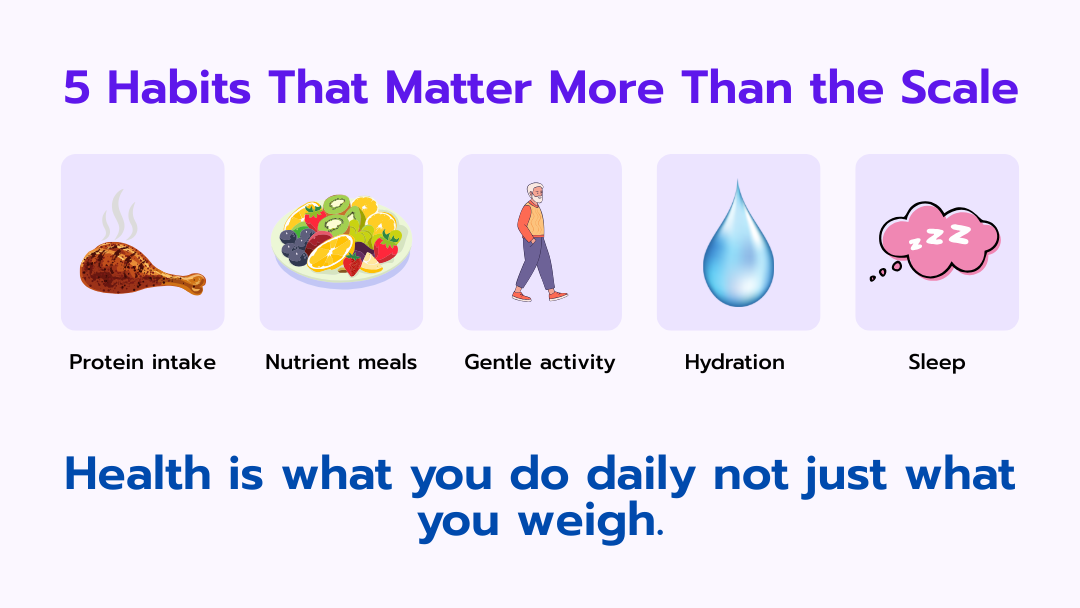
“Healthy BMI for elderly adults is achieved not by dieting, but by eating for strength, moving for stability, and aging with intention beyond the number.”
When to Talk to a Doctor Interpreting BMI in Real Life
Not every BMI result requires medical concern — but in older adults, sudden changes or unusual patterns in BMI may signal something deeper. Whether your result falls below, within, or above the suggested range, there are moments when it’s best to consult a healthcare provider.
This is especially true if you’re using a BMI calculator for adults over 65, since normal aging and muscle loss can disguise real issues behind “acceptable” numbers.
When Should Older Adults Be Concerned About BMI?
If any of these apply, it’s time to speak with a doctor:
- Your BMI is under 23 and you’ve unintentionally lost weight
- You’ve experienced muscle weakness, fatigue, or balance issues
- Your BMI is high but you’re losing strength, not just weight
- You have chronic conditions (e.g., diabetes, heart disease) affected by body composition
- Your appetite has changed significantly
- You feel unsure about what your BMI result means or what action to take
What a Doctor May Recommend:
- Functional assessments (balance, grip strength, walking speed)
- Muscle mass evaluation (e.g., DEXA scans or strength testing)
- Nutritional plans to support strength, not weight loss
- Medication reviews to understand how drugs affect weight/BMI
- A holistic view of your ideal BMI for older adults based on your unique physiology
The takeaway? Use your BMI 65+ results as a conversation starter — not a final verdict.
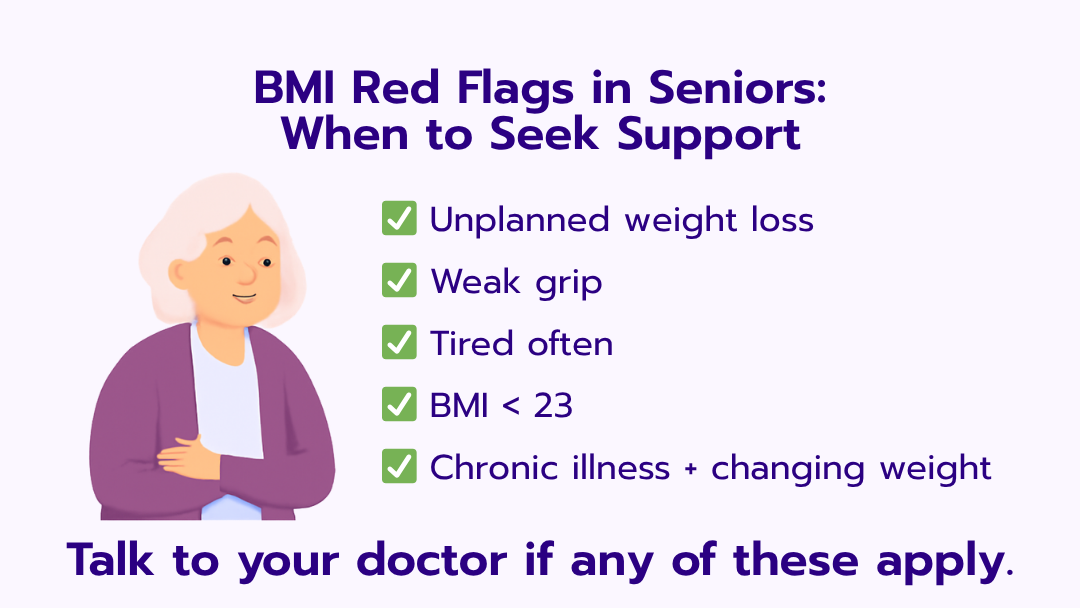
“Whether your result is high or low, interpreting BMI 65+ values in context with support from your doctor leads to safer, more personalized health outcomes.”
Summary Key Takeaways on BMI and Aging
As we age, our bodies undergo significant changes many of which aren’t reflected by traditional BMI charts. For seniors, BMI is just one piece of the puzzle. It can offer insights, but it shouldn’t be the sole measure of health or well-being. Understanding how sarcopenia and muscle loss affect BMI is crucial, as well as recognizing that a slightly higher BMI in older adults may actually be protective.
Rather than obsessing over a single number, focus on strength, function, and overall health. Regular physical activity, a balanced diet, and appropriate hydration are the true markers of well-being not just a BMI reading. Always consult with healthcare professionals when BMI results raise questions or concerns, and remember: healthy aging is about much more than weight.
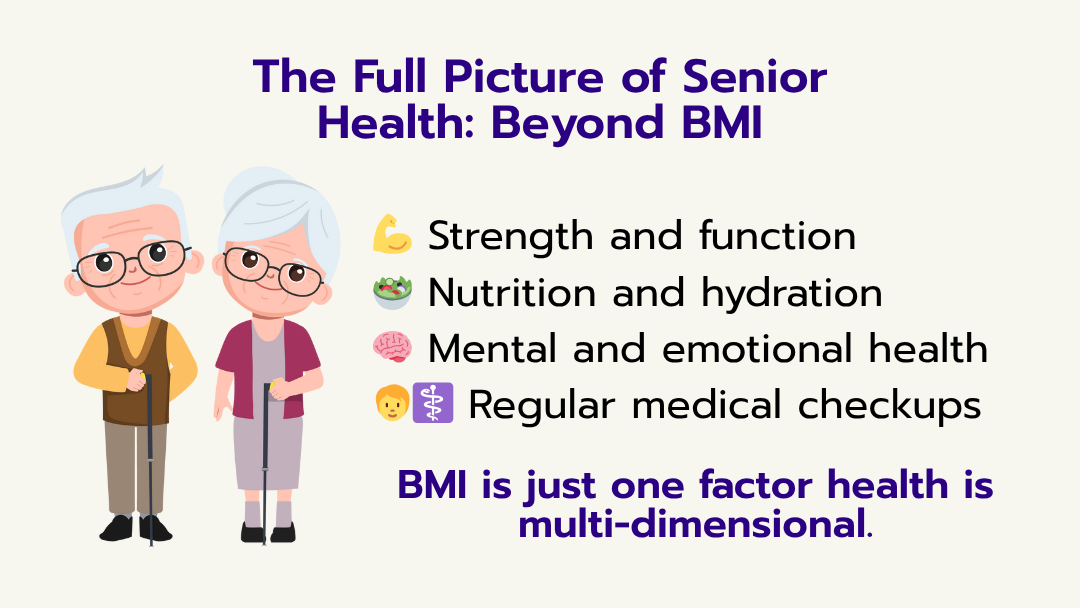
“BMI for older adults isn’t about the number — it’s about staying strong, mobile, and resilient. Focus on the whole picture, not just BMI.”
Explore More BMI Tools for Every Life Stage
As you continue on your journey toward healthier aging, it’s important to have accurate tools that match your life stage. Check out our other BMI calculators tailored to meet the unique needs of individuals at different stages of life:
- 👶 BMI Calculator for Kids — Tailored for children aged 2–12, using age-specific percentiles
- 👩 BMI Calculator for Women — Specially designed for women, taking into account hormonal factors and life stages
- 👨 BMI Calculator for Men — Focuses on male physiology and activity levels
- 👧 BMI Calculator for Teens — Age-appropriate for adolescents, using teen-specific growth charts
- 🧑🦳 BMI Calculator for Seniors — Age-appropriate for seniors, addressing the impact of muscle loss, hydration, and other aging factors
Each tool is built with precision and simplicity to help you understand your BMI accurately and make more informed health decisions.
“Whether you’re helping a child, teen, or senior loved one, our BMI tools provide clarity, insight, and personalized guidance across all life stages.”
Frequently Asked Questions
What is a healthy BMI for seniors?
A healthy BMI for older adults generally ranges from **24 to 29**. This range is often associated with better strength, reduced risk of frailty, and overall stability, as opposed to the lower BMI standards used for younger adults.
What does sarcopenia have to do with BMI?
Sarcopenia refers to the loss of muscle mass with aging. Because muscle weighs more than fat, sarcopenia can result in a misleadingly low BMI, despite a senior being at risk for weakness or frailty. It’s important to consider muscle health, not just BMI, when assessing senior health.
Why is BMI for older adults different from younger adults?
As we age, muscle mass decreases and fat distribution changes. This makes it difficult for traditional BMI charts, which are based on younger adults, to accurately reflect the health of older adults. A BMI slightly higher than the usual “healthy” range may actually be protective against certain health risks in older adults.
How can I interpret my BMI result as a senior?
Use the **BMI calculator for adults** tailored for seniors to get an accurate interpretation. For seniors, a BMI between 24 and 29 is often optimal. However, always consider the full picture: hydration, muscle mass, and overall strength are just as important as the number itself.
Should I worry if my BMI is over 30?
Not necessarily. A BMI over 30 in seniors can sometimes be a result of increased fat around the abdomen, but it can also be linked to protective fat reserves. It’s important to assess how your BMI relates to muscle strength, balance, and overall health rather than focusing solely on the number.
How can I maintain a healthy BMI as I age?
Focus on **eating nutrient-dense foods** to maintain strength and muscle mass, stay **hydrated**, and engage in **regular physical activity** like walking, stretching, or light strength training. Your overall wellness is far more important than trying to fit into a standard BMI range.
Where can I check my BMI using a senior-specific calculator?
You can use our **[BMI Calculator for Seniors](https://bmicount.com/bmi-calculator-for-senior-citizen/)** for a tailored result based on your age and unique needs. It takes into account changes in muscle mass and hydration, offering a more accurate picture of your health.
Is BMI a reliable measure for older adults?
While BMI can provide a helpful starting point, it’s important to understand its limitations in older adults. Factors like muscle loss, hydration, and fat distribution are not captured by BMI alone. Always consider **strength**, **function**, and overall health alongside your BMI result.
